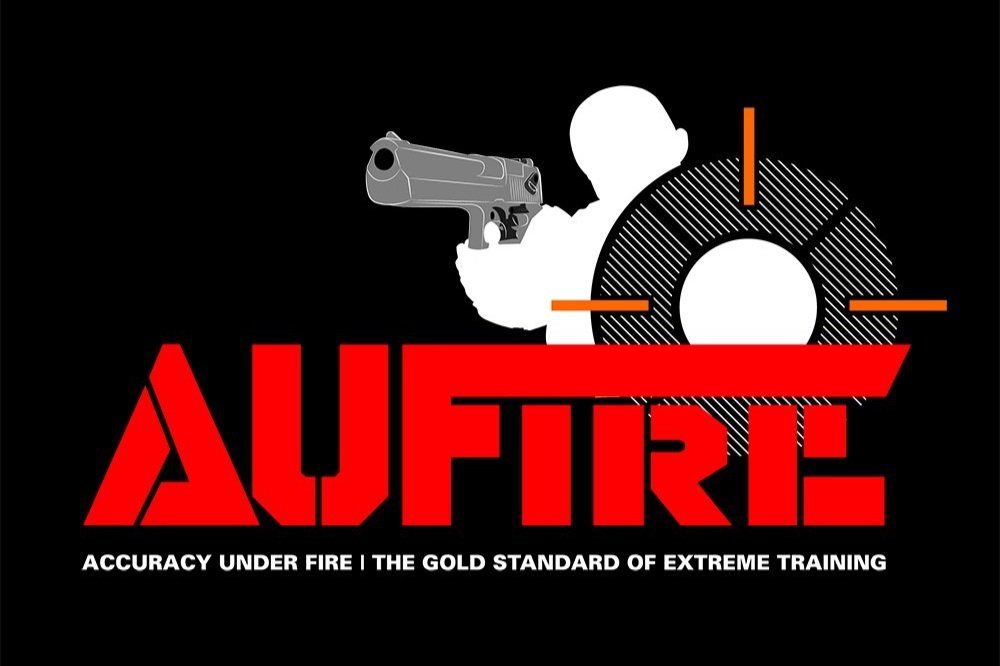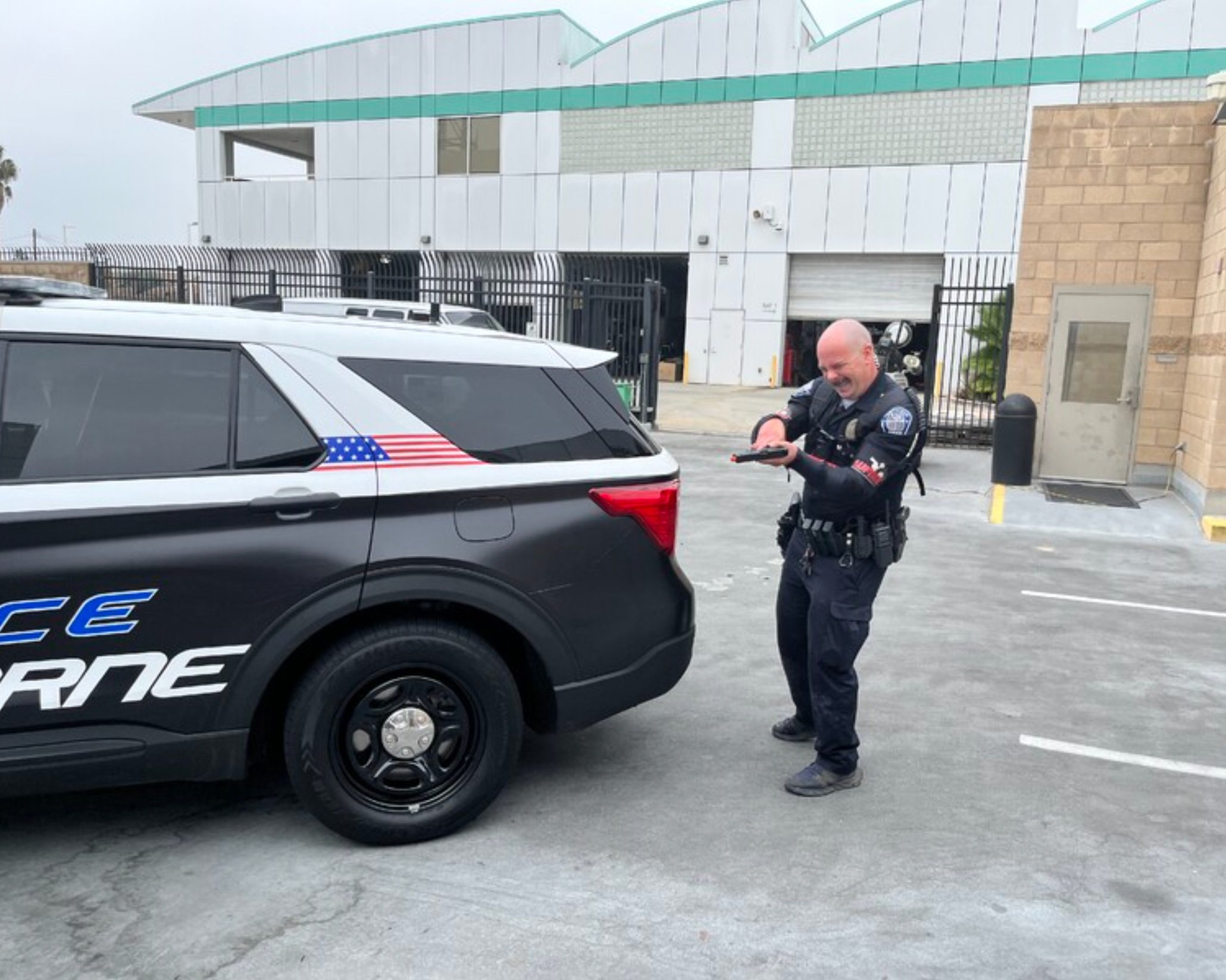Erasing the Reality Gap with AUFIRE!
This article was originally posted on LinkedIn | By Ti Goetz
Just like real life, you have to fight through the pain
Everything begins with an idea.
Tim Pearce was a 10-year veteran Los Angeles police officer when his family’s life was turned upside down. His wife, also a police officer, was shot and paralyzed from the chest down in a violent struggle with a robbery suspect. From that tragedy, Tim would eventually be launched on a multi-year journey of discovery that is only now coming to fruition.
Basic AUFIRE gear: Two officer sleeves, the chest harness with receiver and the instructor controller
Four years after the shooting, Tim was sitting in his bedroom testing his wife’s Transcutaneous Electrical Nerve Stimulation (TENS) machine. While the title makes the equipment sound complicated, TENS is a form of physical therapy that uses low voltage electrical current to provide pain relief. A TENS unit consists of a small, battery-powered device that delivers electrical impulses through electrodes placed on the surface of the skin. These impulses stimulate nerves with involuntary contractions which then send pain blocking signals to the brain.
Being the typical inquisitive law enforcement professional, Tim’s curiosity would soon lead him to a life changing discovery. After tinkering with low power settings, he soon decided the next experimental step would be a full power setting hooked to his bicep. The next activation of the TENS resulted in a “significant” contraction of his left arm, followed immediately by his frantic fumbling with his right arm to shut off the stimulator.
Gasping in shock, he stared down at his arm…….and an idea was born.
A fellow officer, who had been shot in the line of duty, had once told Tim that getting shot was like getting hit by baseball bat; a huge impact, a burning sensation, total immobilization of the area, combined with confusion about what just happened. As his fellow officer’s story flooded into Tim’s mind, the comparisons to what he had just experienced seemed almost identical; sudden shock and confusion at the initiation, combined with an immediate, distracting, totally disabling, loss of motor function.
Could he do something good with this? Could he help his fellow officers somehow? Those were good questions; questions that would drive Tim’s life for the next 10 plus years, resulting, after many experiments and prototypes, in the creation of Accuracy Under Fire Injury Simulator (AUFIRE).
Tim Pierce suits up an officer over his patrol gear
The AUFIRE system is simple to set up and use. It is currently comprised of two electrically conductive sleeves that are worn by the student (future iterations will incorporate attachments for the abdomen and legs). The sleeves are attached to a small receiving unit worn on the student's back. When triggered, the AUFIRE system safely contracts the trainee’s muscles like a cramp, incapacitating the targeted limb to simulate a traumatic injury in an OIS or similar scenario. The effect is immediate, intense, and completely out of the trainee’s control, just like a gunshot wound, knife cut or any physical injury.
A full contraction will require you to pry your weapon from your now completely useless gun hand
Unless someone has been shot or stabbed, most of us have no idea of how it will truly feel, and more importantly, how we would respond to such trauma. Would we stay in the fight, push through the pain, perform under pressure; or would we crumble? There isn’t an officer alive who hasn’t thought through this type of scenario multiple times in his head, gaming out how they would hope to respond if or when that moment comes.
Fighting through the contractions and getting back on target
“Murphy’s Law” being what it is, the “reality gap” between what we “hope” occurs and what actually occurs given the real-world introduction of pain, confusion and shock can often be quite dramatic. Police officers who regularly train on the static range often miss a large percentage of their shots during close range gunfights, officers who have easily applied tourniquets during stress free training suddenly have difficulties applying it as real blood flows, officers trained in active shooter response freeze, hesitate, or don’t do what is expected of them when faced with the real deal.
Having tested one of Tim’s initial prototypes over ten years ago, I was extremely interested in seeing what the latest version brought to the table. After getting suited up, I ran through basic room clearing scenarios while Tim hit me with varying power levels, locking up part or all of one arm or the other with 66 volts of electrical muscle stimulation (safe levels commonly used in therapy). To say it was an eye- opener would be an understatement. The sensation is not necessarily what I would call “painful,” though some might easily describe the cramping as pain, but depending on the power level selected, the sensation was definitely very uncomfortable, and absolutely interfered with my ability to calmly function.
It's a challenge to stay on task while under stimulation
Not only did I lose the use of my arm, but the continuing cramping was a huge distraction and required me to physically and mentally fight through the sensation to stay focused on the ongoing clearing operation. Application of a tourniquet on the affected arm was also extremely challenging. Aside from the technical difficulties involved in the “cheat free” application of the tourniquet, the continuous cramping sensation afflicted my mental abilities and made what had once been a simple task much more difficult. I cannot imagine any other injury simulation more realistic than this one.
Keeping his head on a swivel while applying tourniquet under stimulation (notice arm contraction)
Extremely interested in how some of my peers would handle the simulator, I arranged a training exercise at my department (Hawthorne Police Department) with an assortment of detective, patrol, and SWAT officers. The results were much as I had experienced; that first initial input was an eye-opener and required participants to fight through unwanted bodily responses (dropping to a knee, turning away from the input, losing focus on what was going on). Even well-trained officers found it challenging to overcome the stimulus, fight through the disability and get back on target. Adding tourniquet applications at the end of the scenario proved as tough as my experience had been. Focusing on getting the tourniquet on properly, while under stimulus, and maintaining your security, fully illustrated the mental and physical challenges an officer might face during a real-life injury. Despite the difficulties, every officer who gave it a try thought it was an incredible training tool!
When you can't cheat, you get inventive....pinning the windlass to get your tourniquet tightened!
One of the technical aspects of AUFIRE that agencies may find very useful is that the equipment is already pre-wired for connectivity from firearm training simulators (FATS) typically used in police training such as VirTra, MILO, Street Smarts VR or InVeris. According to Tim, it would require some additional programming on the back end by the simulator company, and most likely an agreement with AUFIRE, but once done the Aufire can be triggered by the system itself to support the video presentation the officer is dealing with. Although this integration still has some hurdles, it is an advantage that it is already set up to accommodate this obviously hopeful future integration.
AUFIRE is simple, versatile, plug-and-play, and it works exceptionally as a stand-alone system with an instructor’s handheld remote. The targeted muscle groups will stay contracted for as long as the instructor dictates. AUFIRE can be used in nearly any training scenario imagined ranging from the classroom to full blown force on force training incorporating projectile training ammunition.
In my 29 years of law enforcement experience, I believe AUFIRE is nothing short of a game changer in performance training under extreme stress! Up to this point, there has been no truly effective way to train “injured officer fight-back drills.” To be honest, most of the time we just tell our officers to “pretend” their arm is injured, which rarely works. Whether they want to or not, they end up instinctively using the “injured” arm in some way, shape or form to assist. The best training ideas to date generally involve tying or handcuffing the primary gun hand behind the back, or duct-taping the arm into a chicken wing to simulate an injury. While these techniques do cut down on the intentional or unintentional assist, there is certainly no realism, no surprise, shock or discomfort, and no opportunity for real stress acclimation.
What I really like about AUFIRE is that it provides officers with hyper-realistic experiences beforehand; it conditions them with new layers of stress inoculation and inspires confidence in those who are expected to potentially fight through worst-case scenarios. Officers can learn to re-focus quickly, prioritize, problem solve, and practice life-saving tactics and skills under real duress from a truly degraded physical condition. Skills under fire such as single-hand weapon reloading, clearing malfunctions, physically fighting back, communicating, and returning fire accurately to stop the threat are just a few of the training benefits I can imagine on the tactical side. On the medical side, the application of tourniquets or performing any other life-saving tactical medical procedures, while under the influence of electrical stimulation, would certainly add a realism to training unparallel to anything done before in the law enforcement or military arena.
AUFIRE is definitely a next generation, cutting edge technology for law enforcement training that will absolutely help close the reality gap, enhance realistic training scenarios, and ultimately, save lives! Kudos to Tim Pierce and UAFIRE, it’s a hell of a product!!








